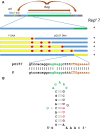Activation, incompatibility, and displacement of FIB replicons in E. coli
- PMID: 40207625
- PMCID: PMC11983097
- DOI: 10.1093/nar/gkaf275
Activation, incompatibility, and displacement of FIB replicons in E. coli
Abstract
Multi-replicon sex-factor F is the archetype of the largest plasmid group in clinical Enterobacteriaceae. Such plasmids spread antimicrobial resistance (AMR) and virulence functions in commensal bacteria of humans and animals. Displacing (curing) these plasmids by blocking replication and neutralizing addiction is successful with the curing cassette on a high-copy-number vector but, with conjugative IncP-1 plasmid RK2 as vector for our "anti-F cassette", displacement of F'prolac is inefficient unless curing-plasmid copy-number is raised 1.5- to 2-fold. Here we report that it is the anti-FIB segment, originating from FIB-FII plasmid pO157, which needs potentiation. We show that the FIB replicon in F (F-FIB) is defective due to a sub-optimal rep ribosome-binding-site (rbs) but can be activated by FIB-Rep protein expressed from our anti-FIB segment joined to RK2. Deleting FIB-rep from the anti-F cassette removed the need for potentiation. A pO157-FIB single-replicon plasmid was displaced efficiently by the complete anti-F cassette without potentiation, but an F-FIB plasmid, mutated to have a pO157-like rep rbs, was not, indicating that sequence divergence between F and pO157 FIB replicons has weakened their negative cross-reactivity. Thus, raising vector copy-number slightly may be sufficient to increase displacement of plasmids similar but not identical to the sequences in the curing cassette.
© The Author(s) 2025. Published by Oxford University Press on behalf of Nucleic Acids Research.
Conflict of interest statement
C.M.T. is Director of the company Plasgene that develops and sells plasmid displacement technology. We do not believe this is a problem because this manuscript is focused on explaining a limitation on the use of certain plasmid displacement tools (curing plasmids). It also reveals fundamental properties of a specific replicon type (FIB) which add significantly to the field of plasmid biology. It does not promote a specific product but it provides general advice about design features which could be used by anyone who has read the paper.
Figures





Similar articles
-
A Newly Incompatibility F Replicon Allele (FIB81) in Extensively Drug-Resistant Escherichia coli Isolated from Diseased Broilers.Int J Mol Sci. 2024 Jul 30;25(15):8347. doi: 10.3390/ijms25158347. Int J Mol Sci. 2024. PMID: 39125914 Free PMC article.
-
Evolution of Regions Containing Antibiotic Resistance Genes in FII-2-FIB-1 ColV-Colla Virulence Plasmids.Microb Drug Resist. 2018 May;24(4):411-421. doi: 10.1089/mdr.2017.0177. Epub 2017 Sep 18. Microb Drug Resist. 2018. PMID: 28922058
-
Potentiation of curing by a broad-host-range self-transmissible vector for displacing resistance plasmids to tackle AMR.PLoS One. 2020 Jan 15;15(1):e0225202. doi: 10.1371/journal.pone.0225202. eCollection 2020. PLoS One. 2020. PMID: 31940351 Free PMC article.
-
Aspects of plasmid F maintenance in Escherichia coli.Can J Microbiol. 1988 Apr;34(4):526-35. doi: 10.1139/m88-090. Can J Microbiol. 1988. PMID: 3052759 Review.
-
Spread and Persistence of Virulence and Antibiotic Resistance Genes: A Ride on the F Plasmid Conjugation Module.EcoSal Plus. 2018 Jul;8(1):10.1128/ecosalplus.ESP-0003-2018. doi: 10.1128/ecosalplus.ESP-0003-2018. EcoSal Plus. 2018. PMID: 30022749 Free PMC article. Review.
References
-
- Lederberg J Cell genetics and hereditary symbiosis. Physiol Rev. 1952; 32:403–30. - PubMed
-
- Hayes W Observations on a transmissible agent determining sexual differentiation in bact. Coli. J Gen Microbiol. 1953; 8:72–8. - PubMed
-
- Top EM, Moënne-Loccoz Y, Pembroke T T et al. .. Thomas CM Phenotypic traits conferred by plasmids. The Horizontal Gene Pool: Bacterial Plasmids and Gene Spread. 2000; Amsterdam, Netherlands: Harwood Academic Publishers; 249–85.10.4324/9780203304334_chapter_6. - DOI
MeSH terms
Substances
Grants and funding
LinkOut - more resources
Full Text Sources

